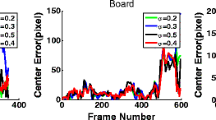Abstract
Visual tracking is a challenging task since it involves developing an effective appearance model to deal with numerous factors. In this paper, we propose a robust object tracking algorithm based on a collaborative model with adaptive selection scheme. Specifically, based on the discriminative features selected from the feature selection scheme, we develop a sparse discriminative model (SDM) by introducing a confidence measure strategy. In addition, we present a sparse generative model (SGM) by combining ℓ1 regularization with PCA reconstruction. In contrast to existing hybrid generative discriminative tracking algorithms, we propose a novel adaptive selection scheme based on the Euclidean distance as the joint mechanism, which helps to construct a more reasonable likelihood function for our collaborative model. Experimental results on several challenging image sequences demonstrate that the proposed tracking algorithm leads to a more favorable performance compared with the state-of-the-art methods.










Similar content being viewed by others
References
Yilmaz A, Javed O, Shah M (2006) Object tracking: a survey. Acm Comput Surv 38(4):81–93
Li X et al. (2013) A survey of appearance models in visual object tracking. Acm Trans Intell Syst Technol 4(4):478–488
Avidan S, Ensemble tracking (2007) IEEE Trans Pattern Anal Mach Intell 29(2):261–271
Grabner H, Bischof H (2006) On-line boosting and vision. In: IEEE computer society conference on computer vision and pattern recognition, pp 260–267
Grabner H, Leistner C, Bischof H (2008) Semi-supervised on-line boosting for robust tracking. In: European conference on computer vision, pp 234–247
Babenko B, Yang MH, Belongie S (2011) Robust object tracking with online multiple instance learning. IEEE Trans Pattern Anal Mach Intell 33(8):1619–1632
Kalal Z, Mikolajczyk K, Matas J (2012) Tracking-learning-detection. IEEE Trans Pattern Anal Mach Intell 34(7):1409–1422
Jiang N, Liu W, Wu Y (2011) Learning adaptive metric for robust visual tracking. IEEE Trans Image Process 20(8):2288–2300
Zhuang, Lu H, Xiao Z (2014) Visual tracking via discriminative sparse similarity map. IEEE Trans Image Process 23(4):1872–1881
Wu G, Zhao C, Lu W et al (2015) Efficient structured L1 tracker based on laplacian error distribution. Int J Mach Learn Cybern 6(4):581–595
Adam A, Rivlin E, Shimshoni I (2006) Robust fragments-based tracking using the integral histogram. In: IEEE computer society conference on computer vision and pattern recognition, pp 798–805
Ross J, Lim J, Lin RS, Yang M (2008) Incremental learning for robust visual tracking. Int J Comput Vision 77(1–3):125–141
Kong J, Liu C, Jiang M, Wu J, Tian S, Lai H (2016) Generalized ℓ P-regularized representation for visual tracking. Neurocomputing 213:155–161
Mei X, Ling H (2009) Robust visual tracking using L1 minimization. In: IEEE international conference on computer vision, pp 1436–1443
Bao C, Wu Y, Ling H, Ji H (2012) Real time robust L1 tracker using accelerated proximal gradient approach. In: Proceedings of IEEE conference on computer vision and pattern recognition, pp 1830–1837
Wang, Lu H, Yang M-H (2013) Online object tracking with sparse prototypes. IEEE Trans Image Process 22(1):314–325
Jia X, Lu H, Yang M (2012) Visual tracking via adaptive structural local sparse appearance model. In: Proceedings of IEEE conference on computer vision and pattern recognition, pp 1822–1829
Liu H, Yuan M, Sun F, Zhang J (2014) Spatial neighborhood-constrained linear coding for visual object tracking. IEEE Trans Ind Inf 10(1):469–480
Liu R, Cheng J, Lu H (2009) A robust boosting tracker with minimum error bound in a co-training framework. Proceedings 30(2):1459–1466.
Dinh TB, Medioni GG (2011) Co-training framework of generative and discriminative trackers with partial occlusion handling. In: IEEE workshop on the applications of computer vision, pp 642–649.
Zhong W, Lu H, Yang M (2014) Robust object tracking via sparse collaborative appearance model. IEEE Trans Image Process 23(5):2356–2368
Zhao L, Zhao Q, Chen Y, Lv P (2016) Combined discriminative global and generative local models for visual tracking. J Electron Imaging 25(2):023005
Wang Q, Chen F, Xu W, Yang M-H (2012) Online discriminative object tracking with local sparse representation. In: IEEE workshop on the applications of computer vision, pp 425–432.
Zhang T, Ghanem B, Liu S, Ahuja N (2013) Robust visual tracking via structured multi-task sparse learning. Int J Comput Vis 101(2):367–383
Zhang T, Ghanem B, Liu S, Ahuja N (2012) Low-rank sparse learning for robust visual tracking. In: European conference on computer vision, pp 2042–2049
Wang D, Lu H, Yang M (2016) Robust visual tracking via least soft-threshold squares. IEEE Trans Circuits Syst Video Technol 26(9):1709–1721
Wang D, Lu H, Bo C (2015) Fast and robust object tracking via probability continuous outlier model. IEEE Trans Image Process 24(12):5166–5176
Hale T, Yin W, Zhang Y (2008) Fixed-point continuation for ℓ1-minimization: methodology and convergence. Siam J Optim 19(3):1107–1130
Wang D, Lu H, Bo C, Visual (2014) Tracking via weighted local cosine similarity. IEEE Trans Cybern 45(9):1838–1850
Xiao Z, Lu H, Wang D (2014) L2-RLS-based object tracking. IEEE Trans Circuits Syst Video Technol 24(8):1301–1309
Pan J, Lim J, Su Z, Yang M (2014) L0-regularized object representation for visual tracking. In: Proceedings British machine vision conference
Everingham M, Van Gool L, C. K. I. Williams, Winn J, Zisserman A (2010) The pascal visual object classes (voc) challenge. Int J Comput Vis 88(2):303–338
Acknowledgements
This work was partially supported by the National Natural Science Foundation of China (61362030, 61201429), the Project Funded by China Postdoctoral Science Foundation (2015M581720, 2016M600360), the Project Funded by Jiangsu Postdoctoral Science Foundation (1601216C) and Technology Research Project of the Ministry of Public Security of China (2014JSYJB007).
Author information
Authors and Affiliations
Corresponding author
Electronic supplementary material
Below is the link to the electronic supplementary material.
Supplementary material 1 (MP4 5176 KB)
Rights and permissions
About this article
Cite this article
Liu, T., Kong, J., Jiang, M. et al. Collaborative model with adaptive selection scheme for visual tracking. Int. J. Mach. Learn. & Cyber. 10, 215–228 (2019). https://doi.org/10.1007/s13042-017-0709-1
Received:
Accepted:
Published:
Issue Date:
DOI: https://doi.org/10.1007/s13042-017-0709-1




